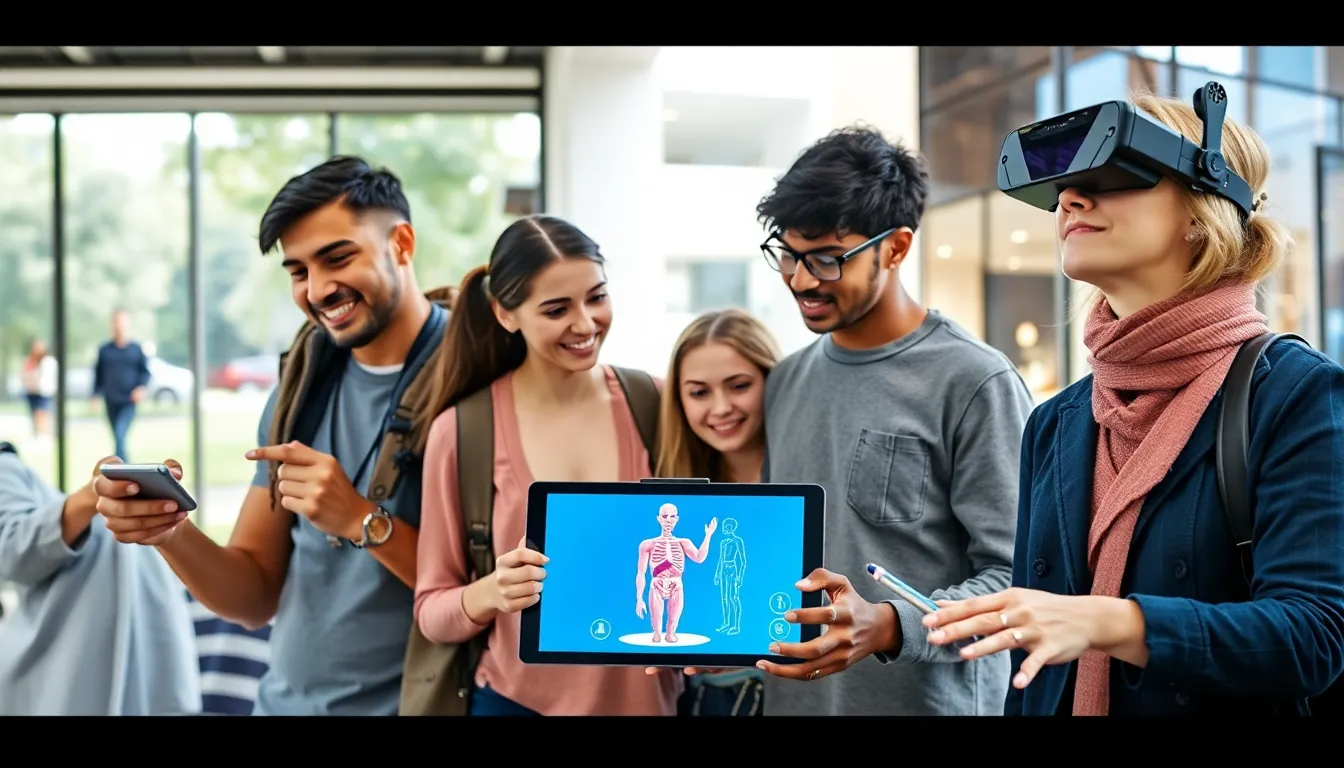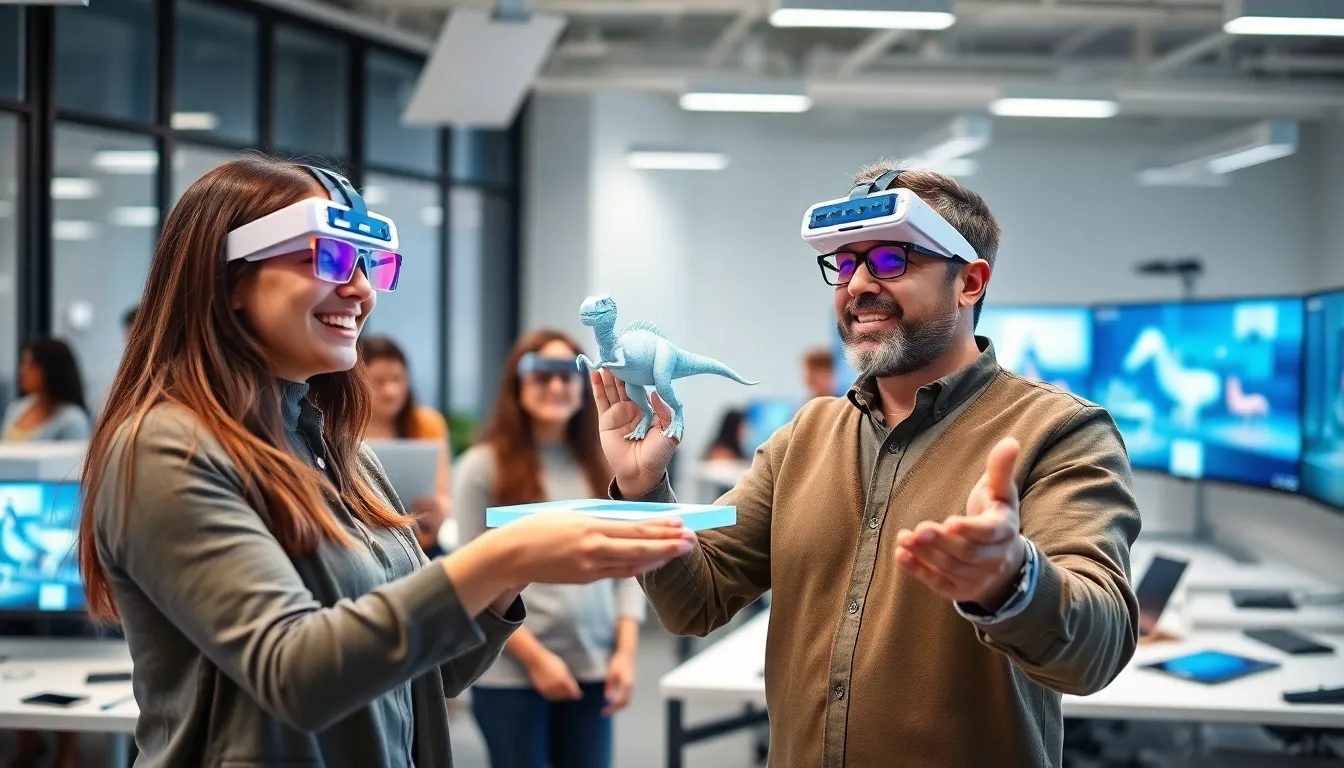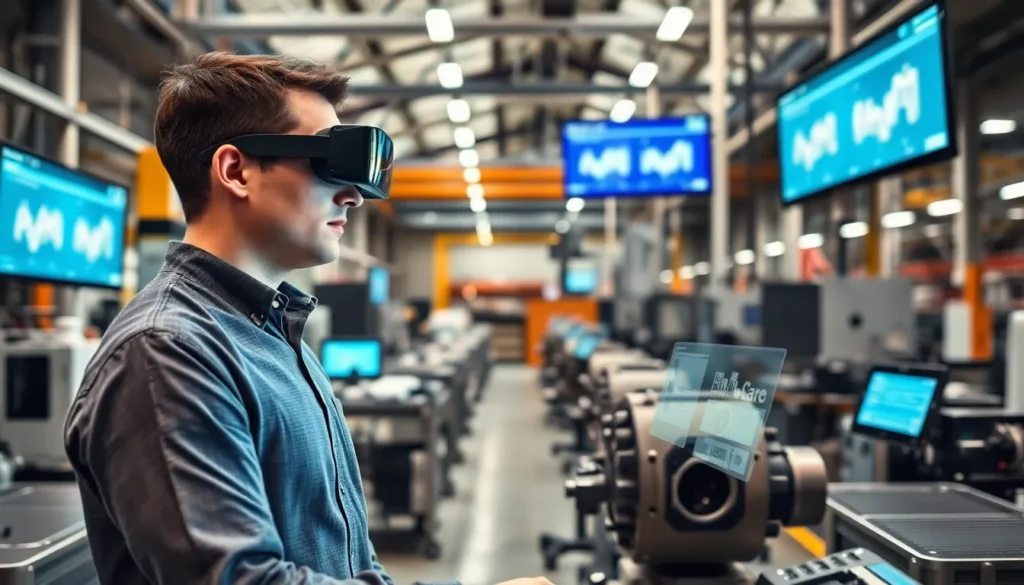Imagine walking through your living room and suddenly seeing a dinosaur munching on your coffee table. Sounds wild, right? That’s the magic of Augmented Reality (AR) technology, where the digital world dances seamlessly with reality. It’s not just for gamers or tech enthusiasts anymore; AR is transforming how businesses operate, how we learn, and even how we shop.
Table of Contents
ToggleOverview of AR Technology
Augmented Reality (AR) technology integrates digital content with the physical world in real time. This innovative method enhances how individuals interact with their environment by overlaying graphics, sounds, and other sensory enhancements. Applications span various fields, transforming industries such as healthcare, where surgeons use AR for complex procedures.
Education also benefits from AR, helping students visualize abstract concepts through interactive simulations. Retailers leverage AR to offer virtual try-ons for clothing and accessories, improving customer engagement and satisfaction. Enhanced navigation and mapping features rely on AR, providing real-time directions and information overlays during travel.
Statistics show that the AR market is expected to reach $100 billion by 2024, highlighting substantial growth and adoption. Companies are investing heavily in AR technology, recognizing its potential to reshape customer experiences and operational efficiencies. During training, employees can utilize AR to simulate real-world scenarios, enhancing learning without real-world risks.
Gaming remains a prominent sector for AR development. Titles like Pokémon GO illustrate how AR can merge gameplay with real-life environments, fostering social interaction and outdoor activity. Beyond entertainment, AR supports architects and designers by visualizing projects before construction.
Compatibility with various devices, including smartphones and smart glasses, enhances AR accessibility. As technology advances, the integration of AR into everyday life becomes more seamless, promising exciting possibilities for the future.
Applications of AR Technology

AR technology disrupts industries by enhancing user experiences across various sectors.
Gaming and Entertainment
Gaming thrives on AR, combining digital elements with real-world environments. Popular games like Pokémon GO demonstrate how players engage with their surroundings, capturing their attention. Enhanced storytelling emerges when AR turns narratives into immersive experiences. Additionally, AR applications in theme parks create captivating attractions, blending the physical and virtual worlds seamlessly. By offering these immersive experiences, AR is setting new standards in entertainment.
Education and Training
Education benefits significantly from AR by providing interactive learning tools. Students visualize complex concepts, fostering deeper understanding. Teachers can use AR apps to create engaging lessons, helping students grasp abstract topics through hands-on activities. Training programs in various industries harness AR to simulate realistic scenarios, allowing employees to practice skills safely. This experiential learning approach enhances retention and application of knowledge, proving AR’s value in education and professional development.
Retail and E-commerce
Retailers leverage AR to transform shopping experiences. Virtual try-on solutions enable customers to see how products fit before purchasing. By offering interactive catalogs, retailers provide customers with more informed choices. Enhanced storefront displays incorporate AR, drawing shoppers into the store by blending digital and physical elements. As AR technology matures, its role in e-commerce continues to evolve, creating more personalized and engaging shopping experiences.
Benefits of AR Technology
AR technology brings significant benefits across various sectors, enhancing functionality and transforming user interactions. Its integration into daily activities streamlines processes and elevates experiences.
Enhanced User Experience
AR enhances user experiences by blending digital elements with the real world. It allows users to visualize products in their environment, making decisions easier. For instance, furniture retailers offer apps that let customers see how a couch fits in their living room. Users can interact with content, gaining a deeper understanding of products. In education, AR visualizes complex concepts, improving learning retention. By engaging with 3D models, students grasp difficult topics more effectively. Overall, AR not only simplifies interactions but also enriches everyday tasks.
Increased Engagement
AR technology significantly increases engagement in various applications. Retail environments utilize AR to create immersive shopping experiences. Virtual try-ons allow customers to experiment with clothing and accessories, boosting confidence in their purchases. Gamification in learning encourages students to explore subjects interactively, fostering enthusiasm for education. Users become active participants, not just passive observers, enhancing their connection to the content. With social media platforms adopting AR filters, individuals find new ways to express themselves creatively. Engagement levels soar as users interact with dynamic content, leading to deeper connections with brands and concepts.
Challenges and Limitations
Augmented Reality (AR) technology faces several challenges and limitations that impact its broader adoption and effectiveness.
Technological Hurdles
Technological progress remains a significant hurdle for AR. Devices often require advanced hardware to support realistic simulations, which can limit accessibility for users. Minimal processing power can lead to lag or poor visual quality, disrupting the user experience. Compatibility among various platforms complicates development, as creators aim to design AR content that works seamlessly across devices. High development costs deter smaller companies from entering the AR market, creating a disparity between large and small enterprises. Without addressing these technological barriers, widespread AR implementation will face obstacles that could slow its growth trajectory.
Privacy Concerns
Privacy concerns pose another obstacle for AR technology. Data collection often includes sensitive personal information, raising alarms among users about how their data is used and shared. Users may feel uncomfortable with AR applications that track their movements or even facial recognition features. Regulations on data privacy can vary by region, complicating compliance for developers and businesses. Failure to adequately protect user privacy can damage trust, negatively affecting user engagement and adoption rates. AR technology must prioritize secure data practices to foster a safe environment for users, enabling broader acceptance and growth.
The Future of AR Technology
AR technology is set to redefine how individuals interact with their environment. The projected market value of $100 billion by 2024 illustrates substantial investment from companies seeking to enhance customer experiences. This growth signifies a shift across various sectors, from retail to education, emphasizing the versatility of AR applications.
Healthcare professionals utilize AR for complex procedures, improving surgical precision. In education, students engage with interactive simulations, allowing clearer visualization of abstract concepts. They gain insights through 3D models, which enhance understanding and retention. Retailers create immersive shopping environments, fostering customer confidence through virtual try-ons.
Manufacturers also invest in AR training modules that simulate real-life scenarios, enhancing employee preparedness. Meanwhile, architects and designers visualize projects before construction, streamlining planning processes. Such innovations underline the importance of AR in enhancing operational efficiencies.
Technological advancements drive AR accessibility. Smartphones and smart glasses enable wider user experiences, breaking down previous barriers. Challenges remain, including high development costs and privacy issues pertaining to data collection. Addressing these obstacles is crucial for broader adoption, requiring companies to prioritize secure data practices.
Social media platforms are incorporating AR filters, facilitating creative expression and deeper brand connections. Engaging with content on these platforms encourages user interaction, showcasing AR’s potential to bridge digital and physical realms. Overall, AR technology is on the precipice of broadening its impact across multiple industries, enhancing user engagement and operational effectiveness.
The future of AR technology is undeniably bright as it continues to reshape how individuals and businesses interact with the world. With its ability to enhance user experiences across various sectors it’s becoming an essential tool for innovation. As companies invest heavily in AR the potential for transformative applications only grows.
While challenges such as high costs and privacy concerns remain the ongoing advancements in technology promise to make AR more accessible. This evolution will likely lead to even more creative and effective uses in everyday life. As AR technology matures it’s set to redefine engagement and operational efficiency across industries.





